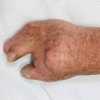Poland's syndrome mimicking traumatic chest injury
- PMID: 34059541
- PMCID: PMC8169489
- DOI: 10.1136/bcr-2020-241408
Poland's syndrome mimicking traumatic chest injury
Abstract
Poland's syndrome (PS) is a rare developmental anomaly that can manifest mild (pectoralis muscles involvement) to severe deformities (rib hypoplasia and hand deformities). We report a case of 69-year-old man who presented to the emergency department with a traumatic chest injury after a fall. It was initially thought to have a significant chest injury as the trauma survey revealed a palpable defect and tenderness in the right anterior chest wall. There was also a symbrachydactyly deformity in the right hand. CT of the chest showed lack of right pectoralis muscles, which were consistent with PS. This case highlights the importance of gathering detail history in adult trauma patients such as congenital disorder especially in the presence of bony deformity. With possibilities of several traumatic conditions in trauma patients eliminated, one can expand the non-traumatic differential, keeping in mind the possibility of a congenital disorder that can mimic traumatic chest injury.
Keywords: congenital disorders; genetic screening / counselling; trauma.
© BMJ Publishing Group Limited 2021. No commercial re-use. See rights and permissions. Published by BMJ.
Conflict of interest statement
Competing interests: None declared.
Figures



Similar articles
-
Poland's syndrome with unusual hand and chest anomalies: a rare case report.Indian J Chest Dis Allied Sci. 2014 Jul-Sep;56(3):191-4. Indian J Chest Dis Allied Sci. 2014. PMID: 25823118
-
Eight patients with multiple bilateral thoracic anomalies: a new syndrome or bilateral Poland's syndrome?Ann Thorac Surg. 2014 May;97(5):1758-63. doi: 10.1016/j.athoracsur.2014.01.027. Epub 2014 Mar 12. Ann Thorac Surg. 2014. PMID: 24630765
-
Computed tomography of the pectoralis muscles in Poland's syndrome.Hand. 1983 Feb;15(1):35-41. doi: 10.1016/s0072-968x(83)80033-3. Hand. 1983. PMID: 6303919
-
[Poland's syndrome].Pol Merkur Lekarski. 2000 Aug;9(50):568-71. Pol Merkur Lekarski. 2000. PMID: 11081328 Review. Polish.
-
Poland syndrome with bilateral features: case description with review of the literature.Am J Med Genet A. 2009 Jul;149A(7):1597-602. doi: 10.1002/ajmg.a.32922. Am J Med Genet A. 2009. PMID: 19533787 Review.
Cited by
-
Consultations for Poland Syndrome: The Essentials for a Thoracic Surgeon.Medicina (Kaunas). 2024 Jul 20;60(7):1178. doi: 10.3390/medicina60071178. Medicina (Kaunas). 2024. PMID: 39064607 Free PMC article. Review.
-
Diagnostic value of chest computed tomography images in adult Poland syndrome: a report of two cases.J Int Med Res. 2022 Jan;50(1):3000605211069485. doi: 10.1177/03000605211069485. J Int Med Res. 2022. PMID: 34994238 Free PMC article.
-
Left-Sided Poland Syndrome With No Hand Anomalies: A Case Report.Cureus. 2022 Dec 31;14(12):e33192. doi: 10.7759/cureus.33192. eCollection 2022 Dec. Cureus. 2022. PMID: 36726931 Free PMC article.
-
An Unusual Case of Left-Sided Poland Syndrome Presenting with Diaphragmatic Hernia and Mediastinal Shift with Absence of Hand and Scapular Deformity.J Orthop Case Rep. 2025 Aug;15(8):169-173. doi: 10.13107/jocr.2025.v15.i08.5928. J Orthop Case Rep. 2025. PMID: 40786750 Free PMC article.
References
-
- Farina D, Gatto G, Leonessa L, et al. . Poland syndrome: a case with a combination of syndromes. Panminerva Med 1999;41:259. - PubMed
Publication types
MeSH terms
LinkOut - more resources
Full Text Sources
Medical
